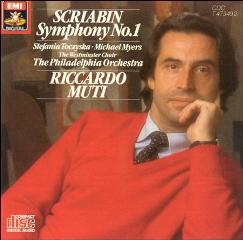Scriabin - Symphony No.1 (Muti) [1986]
Scriabin - Symphony No. 1 (Muti) [1986]

1. I. Lento Riccardo Muti/Philadelphia Orchestra 7:38 2. II. Allegro dramatico Riccardo Muti/Philadelphia Orchestra 8:53 3. III. Lento Riccardo Muti/Philadelphia Orchestra 10:13 4. IV. Vivace Riccardo Muti/Philadelphia Orchestra 3:14 5. V. Allegro Riccardo Muti/Philadelphia Orchestra 7:34 6. VI. Andante Riccardo Muti/Philadelphia Orchestra/Stefania Toczyska/Michael Myers/Westminster Choir 13:03 Stefania Toczyska - mezzo-soprano Michael Myers - tenor The Westminster Choir The Philadelphia Orchestra Riccardo Muti – conductor
While it was fashionable for some at the end of the nineteenth century to defer to the weight and wisdom of history by postponing composition in so ambitious a genre as the symphony until well into one's artistic maturity, Alexander Nikolayevich Scriabin felt no such obligation. He openly conflated the roles of composer and prophet, and assumed an artistic vision virtually unmatched in its cosmic scope. This vision -- which is not hard to extrapolate from the sublime transcendence sought by the Romantic symphonists, though Scriabin conveyed it in a more starry-eyed, self-assured manner than most -- went hand in hand with the unflinching compositional flair that drove him to complete his first symphony at the age of 28.
The work is no trifling undertaking, either -- a sprawling six movements lasting nearly an hour (longer, in fact, than both his second and third symphonies), it addresses no less a subject than the divine nature of art. In fact, in the final movement a chorus and two vocal soloists are employed to sing the praises of artistic creation. This is a gesture, of course, already loaded with meaning: ever since the baritone in the finale of Beethoven's Ninth interrupted the instrumental recollections with "Nay, friends, not these tones!," ushering in the exuberant choral Ode to Joy, the use of a chorus in a symphonic finale has been a signal of heavenly ambition, as if meeting the singing angelic hosts halfway. Scriabin utilizes other tried and true unifying techniques, as well, such as the explicit recall in the final movement of themes heard in earlier movements, and the use, albeit somewhat vestigial, of sonata structure. Some even see the work's six-movement form as a hypertrophied version of the traditional four-movement scheme, with the opening Lento acting as an extended introduction to the subsequent Allegro drammatico, the third movement's Lento positioned in the slow movement's standard inner position, the fourth movement Vivace in the scherzo's spot, and the Allegro in the penultimate, rather than ultimate slot -- which is reserved for the Andante choral movement. The entire work is cast in Scriabin's characteristically lush, chromatic harmonic language, with languorous lines and thick, viscous, undulating counterpoint. This makes all the more striking the moment midway through the finale when, for the first time in the entire piece, the meter changes from flowing triple divisions to the steady, articulate 4/4 meter that carries the piece to its conclusion. ---Jeremy Grinshaw, Rovi
download: uploaded yandex 4shared mediafire mega zalivalka filecloudio anonfiles oboom
Last Updated (Sunday, 04 May 2014 17:15)








